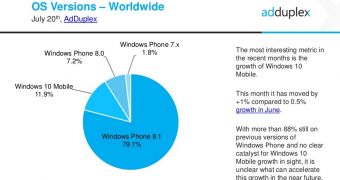Microsoft launched Windows 10 Mobile earlier this year, after such a long wait, but due to the fact that only half of the Windows Phone device lineup can actually run it, adoption figures are significantly impacted these days.
New data provided by AdDuplex shows that Windows Phone 8.1 continues to dominate Microsoft’s mobile ecosystem with a share of no less than 79.1 percent while Windows 10 Mobile is far behind with just 11.9 percent.
Truth be told, Windows 10 Mobile has managed to increase its share by nearly 1 percent over the previous month, but this is still small growth for a new operating system that was supposed to bring so many improvements as compared to its predecessors. Furthermore, 7.2 percent of the users are still running Windows Phone 8.0 while 1.8 percent of them are on Windows Phone 7.
“With more than 88 percent still on previous versions of Windows Phone and no clear catalyst for Windows 10 Mobile growth in sight, it is unclear what can accelerate this growth in the near future,” the AdDuplex report states.
No other Lumia phone
Indeed, no clear catalyst to support the Windows 10 Mobile growth seems to exist, despite the imminent arrival of the Windows 10 Anniversary Update, which will also be released on phones.
Microsoft is no longer planning to release new Lumia devices, and word is that the company will continue with just one model, and this could be the long-rumored Surface Phone due in the spring of 2017.
For the moment, however, Redmond says that it’s supporting the Windows 10 Mobile ecosystem and allowing partners to bring more devices to the market, but as you can easily tell just by looking at this data, the new mobile operating system is growing at a really slow pace.
Things could change in the coming months, when new phones, including the HP Elite X3, are projected to hit the market, but their impact is likely to be minimal, as these are devices aimed at the enterprise, and not necessarily at consumers.

 14 DAY TRIAL //
14 DAY TRIAL //